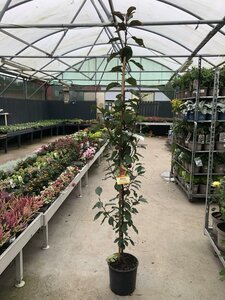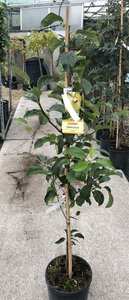Introduction to Conference Pear
The Conference pear (Pyrus communis), one of the most popular and widely cultivated pear varieties, is renowned for its sweet flavor, smooth texture, and versatility in both cooking and fresh consumption. This pear variety has been cultivated for over a century and continues to be a favorite due to its unique characteristics and exceptional qualities. Here is a comprehensive overview of Conference pears and essential details on their care.
Characteristics of the Conference Pear
- Shape and Appearance: The Conference pear has an elongated, bell-shaped form, typically narrower at the stem and rounder at the bottom. It features a greenish-brown russeted skin, which can sometimes take on a golden hue when fully ripe.
- Taste: Known for its sweet, juicy flesh with a grainy texture, Conference pears offer a mildly fragrant and slightly nutty flavor. They are excellent for fresh consumption or cooking and baking.
- Ripening: This variety is unique in that it can be eaten either firm and crisp or soft and juicy, depending on ripeness. When fully ripe, the skin becomes softer, and the flesh turns sweeter and more succulent.
- Harvest Season: Conference pears are typically harvested in late September or early October. They store well and can last several months under proper conditions, making them available for much of the year.
Ideal Growing Conditions
- Climate: Conference pears thrive in temperate climates with cool winters and mild summers. They require a period of winter chilling (a certain number of hours below 7°C or 45°F) to properly flower and set fruit.
- Soil Requirements: These pears prefer well-drained, fertile soils with good moisture retention. A pH level of 6.0 to 7.0 is ideal. Heavy clay soils should be avoided unless adequately amended to improve drainage.
- Sunlight: Full sun is essential for optimal fruit development. Conference pear trees should be planted in areas that receive at least six hours of direct sunlight each day.
- Watering: Regular watering is crucial during the first few years after planting to establish a healthy root system. Once established, Conference pear trees are fairly drought-tolerant, but supplemental irrigation during dry periods is beneficial for fruit development.
Planting and Pruning Conference Pear Trees
- Planting Time: The best time to plant Conference pear trees is in late autumn or early spring when the soil is workable and not frozen. Bare-root trees are often planted during these times, while container-grown trees can be planted year-round as long as they are adequately watered.
- Planting Depth: Dig a hole twice as wide and deep as the tree's root ball. Ensure the graft union (where the tree has been grafted onto rootstock) is at least 2-3 inches above the soil surface.
- Spacing: Conference pear trees can grow up to 5-7 meters tall, so it's important to space them about 4-6 meters apart. This allows enough room for the canopy to develop and ensures proper air circulation.
- Pruning: Pruning Conference pear trees is essential for maintaining their health, improving air circulation, and promoting fruit production. Prune in late winter or early spring, removing any dead, diseased, or damaged branches. Thin out crowded areas in the canopy to allow sunlight to reach the interior.
Fertilization and Pest Management
- Fertilization: Regular fertilization is crucial for strong growth and fruit production. Apply a balanced fertilizer (e.g., 10-10-10) in early spring before new growth begins. Organic compost or well-rotted manure can also be worked into the soil around the tree's base to provide nutrients. Avoid excessive nitrogen, as this can lead to lush foliage at the expense of fruit production.
- Mulching: Applying a layer of mulch around the base of the tree helps retain soil moisture, regulate soil temperature, and suppress weed growth. Keep mulch a few inches away from the trunk to prevent rot.
- Pest and Disease Management: Conference pear trees can be susceptible to several pests and diseases. Common pests include aphids, pear psylla, and codling moths. Natural predators like ladybugs and lacewings can help control aphid populations. Insecticidal soaps or horticultural oils can be applied as a last resort.
- Fire Blight: This bacterial disease can affect Conference pears, leading to wilting and blackened branches. Prune out affected areas and disinfect pruning tools between cuts to prevent the spread of the disease.
- Scab: Pear scab can cause dark, scaly lesions on the fruit and leaves. Fungicidal sprays can help control scab outbreaks, especially during wet seasons.
- Prevention: Regular monitoring and maintaining good hygiene by clearing fallen leaves and fruit from around the tree can significantly reduce disease risk.
Harvesting and Storing Conference Pears
- Harvesting: Conference pears are usually harvested in late September or early October, when they are firm but mature. The fruit should be picked before it ripens fully on the tree. Gently lift the pear upwards, and if it detaches easily, it is ready for harvest.
- Post-Harvest Ripening: Conference pears ripen off the tree. Once harvested, they should be stored in a cool, dry place, such as a refrigerator, to extend their shelf life. To ripen, bring them to room temperature for a few days, depending on your preference for firmness or juiciness.
- Storage: Properly stored Conference pears can last for several weeks, even months. They should be checked regularly for signs of overripeness or spoilage.
Conclusion
Conference pears are a versatile and delicious fruit that can thrive with the proper care. By providing them with the right growing conditions, regular maintenance, and protection from pests and diseases, you can enjoy an abundant harvest each year. Whether eaten fresh, baked into pies, or cooked down into jams, Conference pears continue to be a cherished fruit around the world
- Latin namePEAR CONFERANCE
- Size10 lt
|
Standard Delivery per parcel* |
€7.95 |
|
* parcels up to 30kg or within dimensions volume |
|
|
* free delivery over €250 on standard items (excludes large/bulky items) |
|
|
* multiple purchases qualify for combined delivery |
|
|
For large items please ring us on 069-64084 to discuss delivery. |
|
We currently only deliver within the island of Ireland, other countries can be quoted for by contacting [email protected] or via telephone on 06964084
Standard Delivery is FREE on orders over €250*
All standard deliveries will be completed within 5-7 working days via Fastway Couriers, any delay to this delivery time, the customer will be notified by One of our staff.
The in-Store delivery charge will vary compared with online, in-store delivery charge is done on a case by case basis.
* Only mainland Ireland addresses qualify for free delivery.
Live Plants Delivery
Our live plants are packed with care and diligence by our staff, our horticulturists review each plant before despatch to ensure quality is maintained.
Live Plant delivery charges are not calculated on weight but on the space required per package to ensure safe delivery, so delivery charges may vary as some plants require more space than others when packed.
All live plants are despatched within 3-5 working days where possible, our couriers aim to deliver within 48 hours of despatch from our Garden Centre to allow the plant to arrive in healthy condition.
Click & Collect
Can’t wait for delivery? Why not try our FREE Click & Collect service? Simply make your purchase online and collect it from our store located in Croagh Co. Limerick. Our staff will contact you by phone when your order is ready for collection (Please allow 24 hours minimum). When collecting your item, call the store on 069-64084. We will then load into your car as required. This service is available in-store 9am – 6pm Monday – Saturday (No collections on Sundays)
Click here for more information about our shipping conditions.
You can pay your online order either by credit card or via Paypal.
If you have any further questions about the online order payment please contact us via 069 640 84 or mail.
Are you looking for %name"? We offer this product in our garden centre in Ballycannon, Croagh, near Kilmallock, Charleville, Limerick, Adare and Ballingarry. You can order PEAR CONFERANCE online or you can visit our garden centre in Ballycannon, Croagh, Limerick for more information about the product "PEAR CONFERANCE". We look forward to seeing you soon!
Write a review about "PEAR CONFERANCE"
We want to know your opinion! Write a review about the product “PEAR CONFERANCE”




